One of the most interesting 'battles' is Apple's X-series iPad chips (faster, more powerful versions of the iPhone SoC's) vs Intel's Core M chips, but something has happened very recently that has really turned this on its head: there are now real, true i5 Windows tablets that are fanless! the 2017 Surface Pro is the direct competition to the iPad of course but apparently Acer was the first. https://www.windowscentral.com/surface-pro-2017-core-i5-review I didn't expect to see fanless i5 tablets until 10nm so I'm quite surprised. Also surprised more people aren't talking about this!
In Apple vs Intel, new fanless i5 tablets are a game changer
- Thread starter willfr
- Start date
You are using an out of date browser. It may not display this or other websites correctly.
You should upgrade or use an alternative browser.
You should upgrade or use an alternative browser.
NTMBK
Lifer
- Nov 14, 2011
- 10,232
- 5,013
- 136
It looks like it's using the same trick as the old Shield K1 tablet- use the entire back of the tablet as a radiator. The Shield K1 had a solid magnesium sheet, and the new Surface Pro has a spider-like heatsink.
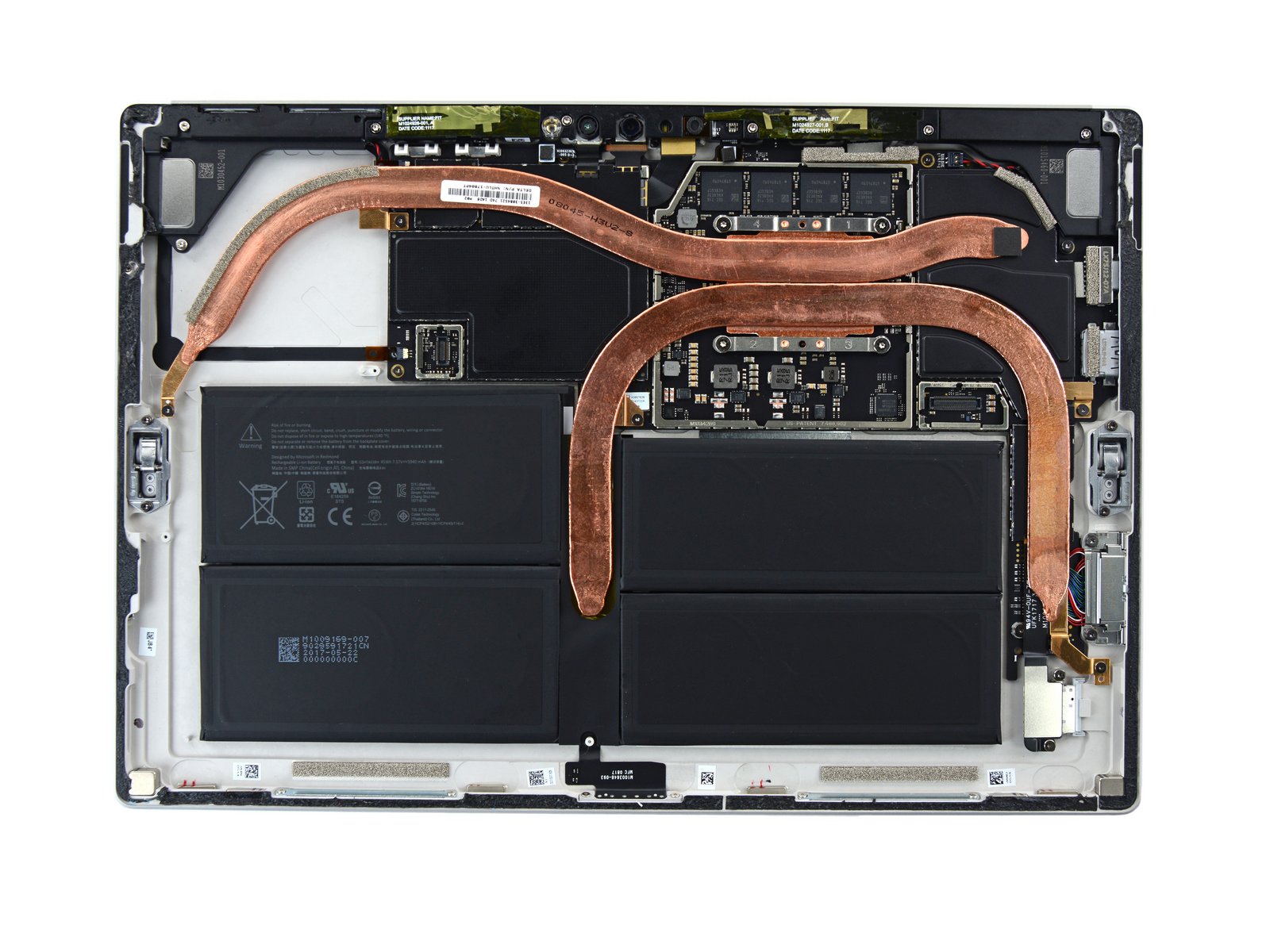

John Carmack
Member
- Sep 10, 2016
- 155
- 247
- 116
Tablets with the old 5W Core M chips would throttle if you pushed them hard enough. Let's hold off on calling this a game changer shall we?
dave_the_nerd
Lifer
- Feb 25, 2011
- 16,788
- 1,468
- 126
Roland00Address
Platinum Member
- Dec 17, 2008
- 2,196
- 260
- 126
How is this a game changer? It is quite amazing and beautiful in its own way, but calling it a game changer just sounds like hyperbole.
We are playing the same game still, and while getting sustained performance of i5 15w class is a big deal, it is not going to be the factor that causes someone to buy an apple ipad or a windows surface pro 2017 or vice versa. Software both the OS and the apps are going to be what makes you choose one or the other.
Pretty much I just dislike hyperbole, and sports metaphors. What can I say it is the geek in me
We are playing the same game still, and while getting sustained performance of i5 15w class is a big deal, it is not going to be the factor that causes someone to buy an apple ipad or a windows surface pro 2017 or vice versa. Software both the OS and the apps are going to be what makes you choose one or the other.
Pretty much I just dislike hyperbole, and sports metaphors. What can I say it is the geek in me
Eug
Lifer
- Mar 11, 2000
- 23,586
- 1,000
- 126
Basically it sounds like the Y and U series chips are on a continuum, and where you decide to set the wattage determines what the performance will be.
MS decided to take 15 W chips and set them for use at 7.5 Watts, and Apple decided to take 4.5 Watt chips and set them a bit higher.
Surface Pro 2017 i5-7300U 4,302 8,482
It should be noted the MacBook Core i7 (Y series) gets right around the same score as that Surface i5 U series:
http://browser.primatelabs.com/v4/cpu/3176817
In fact, in Geekbench, the MacBook i7 Y actually beats that Surface i5 U.
MacBook10,1 i7-7Y75 @ 1.4 GHz: 4488 8486
Sure, the MacBook will probably throttle, but that's not so much the chip as the cooling design and form factor. Change the design a bit, and it won't throttle, but then you'll give up some of the sleekness they're known for.
BTW, I bought the m3-7Y32 which at 1.2 GHz plus Turbo Boost gets around 3800 7000 or so.
http://browser.primatelabs.com/v4/cpu/search?dir=desc&q=macbook10,1+m3&sort=multicore_score
More important to me though is that since it is Kaby Lake, it will play high bitrate h.265 HEVC without breaking a sweat, and that includes both 8-bit and 10-bit files. That is far more important to me than a few hundred Geekbench points.
MS decided to take 15 W chips and set them for use at 7.5 Watts, and Apple decided to take 4.5 Watt chips and set them a bit higher.
Surface Pro 2017 i5-7300U 4,302 8,482
It should be noted the MacBook Core i7 (Y series) gets right around the same score as that Surface i5 U series:
http://browser.primatelabs.com/v4/cpu/3176817
In fact, in Geekbench, the MacBook i7 Y actually beats that Surface i5 U.
MacBook10,1 i7-7Y75 @ 1.4 GHz: 4488 8486
Sure, the MacBook will probably throttle, but that's not so much the chip as the cooling design and form factor. Change the design a bit, and it won't throttle, but then you'll give up some of the sleekness they're known for.
BTW, I bought the m3-7Y32 which at 1.2 GHz plus Turbo Boost gets around 3800 7000 or so.
http://browser.primatelabs.com/v4/cpu/search?dir=desc&q=macbook10,1+m3&sort=multicore_score
More important to me though is that since it is Kaby Lake, it will play high bitrate h.265 HEVC without breaking a sweat, and that includes both 8-bit and 10-bit files. That is far more important to me than a few hundred Geekbench points.
Last edited:
Ratman6161
Senior member
- Mar 21, 2008
- 616
- 75
- 91
I'd completely disagree that the surface pro and the iPad are direct competitors. They are very different devices aimed at different market niches.One of the most interesting 'battles' is Apple's X-series iPad chips (faster, more powerful versions of the iPhone SoC's) vs Intel's Core M chips, but something has happened very recently that has really turned this on its head: there are now real, true i5 Windows tablets that are fanless! the 2017 Surface Pro is the direct competition to the iPad of course but apparently Acer was the first. https://www.windowscentral.com/surface-pro-2017-core-i5-review I didn't expect to see fanless i5 tablets until 10nm so I'm quite surprised. Also surprised more people aren't talking about this!
ZGR
Platinum Member
- Oct 26, 2012
- 2,052
- 656
- 136
I'd completely disagree that the surface pro and the iPad are direct competitors. They are very different devices aimed at different market niches.
In fact, I'd argue that they complement each other quite nicely.
Arachnotronic
Lifer
- Mar 10, 2006
- 11,715
- 2,012
- 126
I'd completely disagree that the surface pro and the iPad are direct competitors. They are very different devices aimed at different market niches.
Agree.
The Y and U series chips are pretty much the same silicon, just in a different package to support different TDP. The notion of "real i5" is inherently flawed.
Whatever you set the TDP determines the performance you get. It is safe to assume that Microsoft did not set the TDP of the U series chip in the Surface Pro to default 15W but maybe half of that.
Nothing to see here....in particular no game changer.
Whatever you set the TDP determines the performance you get. It is safe to assume that Microsoft did not set the TDP of the U series chip in the Surface Pro to default 15W but maybe half of that.
Nothing to see here....in particular no game changer.
Azuma Hazuki
Golden Member
- Jun 18, 2012
- 1,532
- 866
- 131
That said, can this thing really handle a 15W TDP? Even supposedly using the back of the case itself as a heatsink? The copper "spider" looks much too small. Is Intel setting these things cTDP down to 10W or something? This just doesn't add up.
Edit: Wow, according to the review, nope, it's not only at full spec but actually hits 3.5 GHz @18W for 10+ minutes at a time. I have no idea how the heck they did this. What I wonder now is, is there any point to the Y-series anymore?
Edit: Wow, according to the review, nope, it's not only at full spec but actually hits 3.5 GHz @18W for 10+ minutes at a time. I have no idea how the heck they did this. What I wonder now is, is there any point to the Y-series anymore?
Eug
Lifer
- Mar 11, 2000
- 23,586
- 1,000
- 126
Battery life.That said, can this thing really handle a 15W TDP? Even supposedly using the back of the case itself as a heatsink? The copper "spider" looks much too small. Is Intel setting these things cTDP down to 10W or something? This just doesn't add up.
Edit: Wow, according to the review, nope, it's not only at full spec but actually hits 3.5 GHz @18W for 10+ minutes at a time. I have no idea how the heck they did this. What I wonder now is, is there any point to the Y-series anymore?
That said, can this thing really handle a 15W TDP? Even supposedly using the back of the case itself as a heatsink? The copper "spider" looks much too small. Is Intel setting these things cTDP down to 10W or something? This just doesn't add up.
Edit: Wow, according to the review, nope, it's not only at full spec but actually hits 3.5 GHz @18W for 10+ minutes at a time. I have no idea how the heck they did this. What I wonder now is, is there any point to the Y-series anymore?
As i said, Y series is the same core just in another package. Its smaller and takes less PCB space and thus it is harder to dissipate heat.
It is also clear from the review that the Core throttles to 2.6GHz with only the 2 cores being active. Now imagine running a game, where the GPU adds significant power on top, it would need to throttle even more.
SAAA
Senior member
- May 14, 2014
- 541
- 126
- 116
Edit: Wow, according to the review, nope, it's not only at full spec but actually hits 3.5 GHz @18W for 10+ minutes at a time. I have no idea how the heck they did this. What I wonder now is, is there any point to the Y-series anymore?
Core powered phones, credit card sized (not atoms...) pcs? If 14nm isn't enough maybe 10nm Cannonlake will do it. I'm awaiting to see what they can do in 5W envelope with a process that's supposedly better than 14nm+, lower power and smaller.
Maybe the first Y core will be duds, as were the first Broadwell's before, but in a year or so I can definitely see them improving on all fronts over Kabylake and fitting in 5-6" devices with little throttling. Maybe optane memory too? Nah daydreaming much, they can't kill current phones this brutal way, they are focused on servers now...
I don't think Windows Central is lying or wrong, but of course I would like to see Anandtech do their own tests too. And while they're at it, they should test the Acer Switch Alpha 12 which is apparently the first fanless i5 device, it would be interesting to see how it compares to the 2017 Surface Pro i5. Either way, from this point forward it would be wrong to compare iPad X series to Intel's "core m", real shipping tablets have fanless i5 now.
Roland00Address
Platinum Member
- Dec 17, 2008
- 2,196
- 260
- 126
Repeat after me.
Skylake and Kabylake U series (15w cpus) are the same exact cpus as Skylake and Kabylake Y series (4.5w cpus). They are literally from the same silicon wafer, aka they are made from the same sand, where we take this sand, make it into a wafer, and then via the power of light we etch a cpu / soc onto the wafer.
A package is not the same thing as the silicon wafer. While the silicon is sand, a package is what surrounds the sand and is made out of plastic and metal wires. Those metal wires being either pins for socketed cpus, or bga for cpus that are more delicate and smaller and they use a machine to solder the cpu to the motherboard at a factory instead of you doing it later
Put simply the package is what connects the CPU to the motherboard, it is the in between layer.
-----
So literally Intel is using the same silicon, the same wafer, the same sand etched with light in the same cpus, from all the way down to 3.5 watts (a 4.5 watt Skylake or Kabylake Y series with cTDP down) to 25 watts (a 15 watt Skylake or Kabylake U series with cTDP up)
So currently with Kabylake here are the tdp options
3.5w, 4.5w, 6.0w, 7.0 watts which uses the Kabylake Y series package
7.5w, 10.0w, 15.0w, 25.0w which uses the Kayblake U series package.
So why have two different packages? Kabylake Y series package is physically smaller, more expensive to make, and is more energy efficient for they turned off some features on the integrated platform controller hub. On the <30 watt tdp cpus the PCH is not part of the motherboard but part of the SOC, and with the Y series you have less options, it has 2 less pcie express lanes (to save power) and only up to 2 sata ports to save power. Now the PCH for the Y series which is on a different package that takes up more space you have 2 more pci express lanes, and an extra sata port. Note though this integrated into the SoC has far less pci express lanes than any intel cpu with a > 35 watt or higher tdp whether laptop, dekstop, or embedded. Instead of dealing with 10, 12, we are dealing with 20 pcie express lanes. (There are far more on the server / workstation cpus with Skylake-X which can have up to 44 pci express lanes on the most expensive skus but some skus only have 28 lanes.)
See here with images http://www.anandtech.com/show/9582/intel-skylake-mobile-desktop-launch-architecture-analysis/4
So to sum it up, think of it like this.
Silicon as in Sand as in CPU the brain
Package as in Plastic with Metal Wires, as in Spinal Cord that connects the CPU the brain to the motherboard as in everything else. Spinal Cord still very important, but the brain is far more complicated and is the main thing inside of a computer.
Skylake and Kabylake U series (15w cpus) are the same exact cpus as Skylake and Kabylake Y series (4.5w cpus). They are literally from the same silicon wafer, aka they are made from the same sand, where we take this sand, make it into a wafer, and then via the power of light we etch a cpu / soc onto the wafer.
A package is not the same thing as the silicon wafer. While the silicon is sand, a package is what surrounds the sand and is made out of plastic and metal wires. Those metal wires being either pins for socketed cpus, or bga for cpus that are more delicate and smaller and they use a machine to solder the cpu to the motherboard at a factory instead of you doing it later
Put simply the package is what connects the CPU to the motherboard, it is the in between layer.
-----
So literally Intel is using the same silicon, the same wafer, the same sand etched with light in the same cpus, from all the way down to 3.5 watts (a 4.5 watt Skylake or Kabylake Y series with cTDP down) to 25 watts (a 15 watt Skylake or Kabylake U series with cTDP up)
So currently with Kabylake here are the tdp options
3.5w, 4.5w, 6.0w, 7.0 watts which uses the Kabylake Y series package
7.5w, 10.0w, 15.0w, 25.0w which uses the Kayblake U series package.
So why have two different packages? Kabylake Y series package is physically smaller, more expensive to make, and is more energy efficient for they turned off some features on the integrated platform controller hub. On the <30 watt tdp cpus the PCH is not part of the motherboard but part of the SOC, and with the Y series you have less options, it has 2 less pcie express lanes (to save power) and only up to 2 sata ports to save power. Now the PCH for the Y series which is on a different package that takes up more space you have 2 more pci express lanes, and an extra sata port. Note though this integrated into the SoC has far less pci express lanes than any intel cpu with a > 35 watt or higher tdp whether laptop, dekstop, or embedded. Instead of dealing with 10, 12, we are dealing with 20 pcie express lanes. (There are far more on the server / workstation cpus with Skylake-X which can have up to 44 pci express lanes on the most expensive skus but some skus only have 28 lanes.)
See here with images http://www.anandtech.com/show/9582/intel-skylake-mobile-desktop-launch-architecture-analysis/4
So to sum it up, think of it like this.
Silicon as in Sand as in CPU the brain
Package as in Plastic with Metal Wires, as in Spinal Cord that connects the CPU the brain to the motherboard as in everything else. Spinal Cord still very important, but the brain is far more complicated and is the main thing inside of a computer.
cytg111
Lifer
- Mar 17, 2008
- 23,174
- 12,835
- 136
Repeat after me.
Skylake and Kabylake U series (15w cpus) are the same exact cpus as Skylake and Kabylake Y series (4.5w cpus). They are literally from the same silicon wafer, aka they are made from the same sand, where we take this sand, make it into a wafer, and then via the power of light we etch a cpu / soc onto the wafer.
A package is not the same thing as the silicon wafer. While the silicon is sand, a package is what surrounds the sand and is made out of plastic and metal wires. Those metal wires being either pins for socketed cpus, or bga for cpus that are more delicate and smaller and they use a machine to solder the cpu to the motherboard at a factory instead of you doing it later
Put simply the package is what connects the CPU to the motherboard, it is the in between layer.
-----
So literally Intel is using the same silicon, the same wafer, the same sand etched with light in the same cpus, from all the way down to 3.5 watts (a 4.5 watt Skylake or Kabylake Y series with cTDP down) to 25 watts (a 15 watt Skylake or Kabylake U series with cTDP up)
So currently with Kabylake here are the tdp options
3.5w, 4.5w, 6.0w, 7.0 watts which uses the Kabylake Y series package
7.5w, 10.0w, 15.0w, 25.0w which uses the Kayblake U series package.
So why have two different packages? Kabylake Y series package is physically smaller, more expensive to make, and is more energy efficient for they turned off some features on the integrated platform controller hub. On the <30 watt tdp cpus the PCH is not part of the motherboard but part of the SOC, and with the Y series you have less options, it has 2 less pcie express lanes (to save power) and only up to 2 sata ports to save power. Now the PCH for the Y series which is on a different package that takes up more space you have 2 more pci express lanes, and an extra sata port. Note though this integrated into the SoC has far less pci express lanes than any intel cpu with a > 35 watt or higher tdp whether laptop, dekstop, or embedded. Instead of dealing with 10, 12, we are dealing with 20 pcie express lanes. (There are far more on the server / workstation cpus with Skylake-X which can have up to 44 pci express lanes on the most expensive skus but some skus only have 28 lanes.)
See here with images http://www.anandtech.com/show/9582/intel-skylake-mobile-desktop-launch-architecture-analysis/4
So to sum it up, think of it like this.
Silicon as in Sand as in CPU the brain
Package as in Plastic with Metal Wires, as in Spinal Cord that connects the CPU the brain to the motherboard as in everything else. Spinal Cord still very important, but the brain is far more complicated and is the main thing inside of a computer.
- Dude.
Roland00Address
Platinum Member
- Dec 17, 2008
- 2,196
- 260
- 126
Note just to confuse you people (teases). There are actually two different types of Skylake and Kabylake U series CPUs and they are made from different silicon wafers. Same sand, but with a different mask to etch the light onto the sand.
The U series which are the ones with the good graphics, with the ED Ram, are made from a different silicon wafer as the ones with the decent graphics. The U series with the good graphics and ED Ram are 15w and 28w normally but with cTDP up and down you can do the following tdps 9.5 w, 15.0w, 23.0 w, 28.0 w. The 9.5w and 15.0w we call their intel graphics Iris Pro 640, but the 23.0w and 28.0w options we call their Iris Pro 650. What is the difference between the Iris Pro 640 and the Iris Pro 650 in the hardware...there is no difference. But due to the fact the 23.0w and 28.0w tdp options have more graphic headroom (aka more frequency and longer times they can stay at higher frequencies due to having more tdp headroom) Intel thought they deserved a different name and thus both are Iris Pro Kabylake, but one gets a higher model number than the other.
Is this a good dude or a bad dude?
The U series which are the ones with the good graphics, with the ED Ram, are made from a different silicon wafer as the ones with the decent graphics. The U series with the good graphics and ED Ram are 15w and 28w normally but with cTDP up and down you can do the following tdps 9.5 w, 15.0w, 23.0 w, 28.0 w. The 9.5w and 15.0w we call their intel graphics Iris Pro 640, but the 23.0w and 28.0w options we call their Iris Pro 650. What is the difference between the Iris Pro 640 and the Iris Pro 650 in the hardware...there is no difference. But due to the fact the 23.0w and 28.0w tdp options have more graphic headroom (aka more frequency and longer times they can stay at higher frequencies due to having more tdp headroom) Intel thought they deserved a different name and thus both are Iris Pro Kabylake, but one gets a higher model number than the other.
- Dude.
Is this a good dude or a bad dude?
Roland00Address
Platinum Member
- Dec 17, 2008
- 2,196
- 260
- 126
Here is some images to help visualize the words I said earlier.
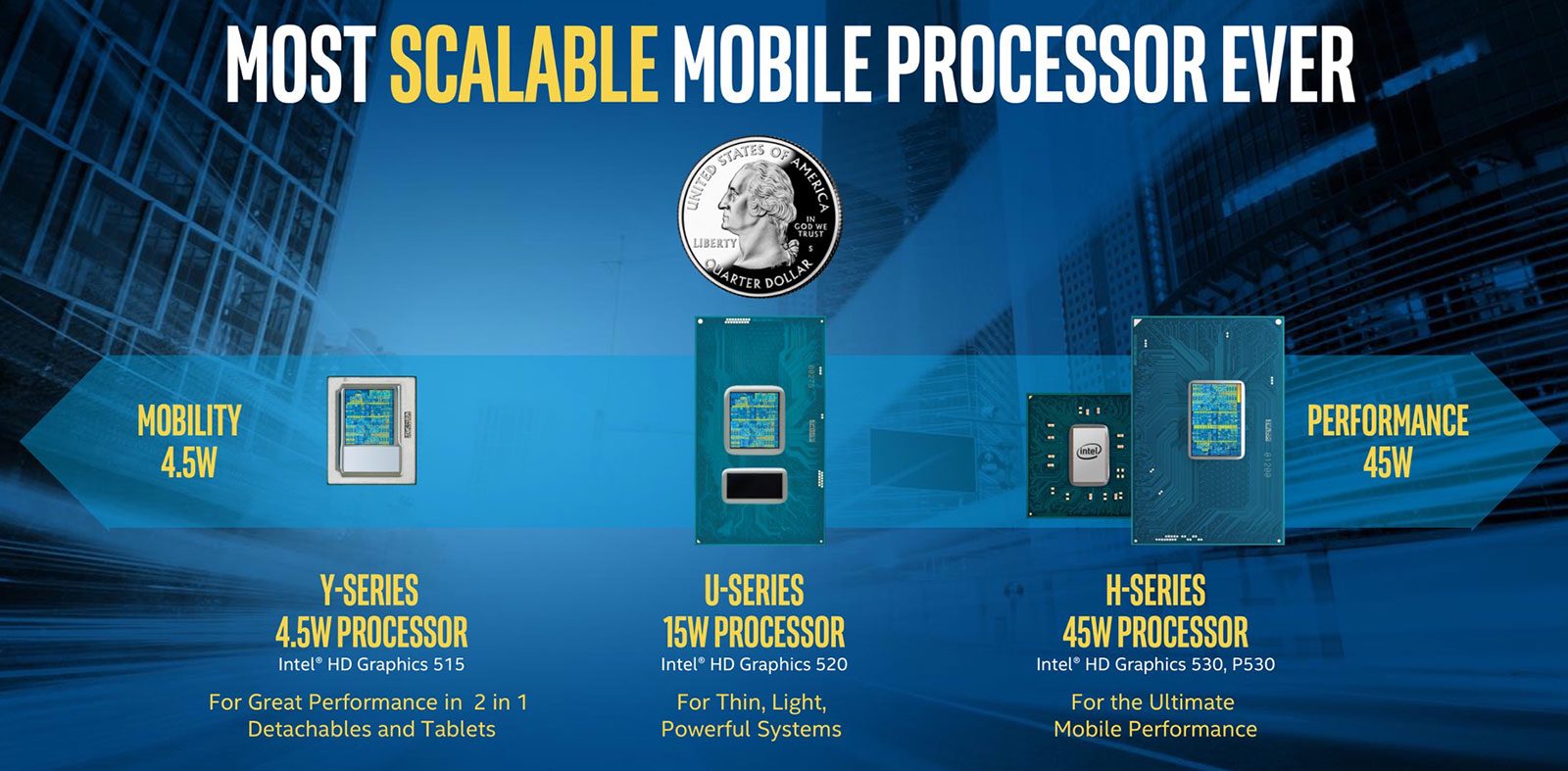
Notice the blue and yellow stuff. That is the cpu silicon. The green stuff is the package (aka plastic and metal wires) The bottom silver / grey stuff is the integrated PCH. This is why there is no silver / grey stuff on the 45w cpu for they put the PCH on the motherboard and there are more options with more pci express lanes but you get the trade off that the package is bigger.
The dimensions of the kabylake / skylake Y series package (FCBGA1515) is 20mm X 16.5mm. To put this in comparison a square inch is 0.78% of an inch by 0.65% of an inch. A postage stamp would be 22.1 mm x 24.9 mm, which is about 0.87 inches x 0.98 inches
The dimensions of the kabylake / skylake U series package (FCBGA1356) by contrast is 42mm X 24mm aka the package of the U series is 3 times the size (305.5%)
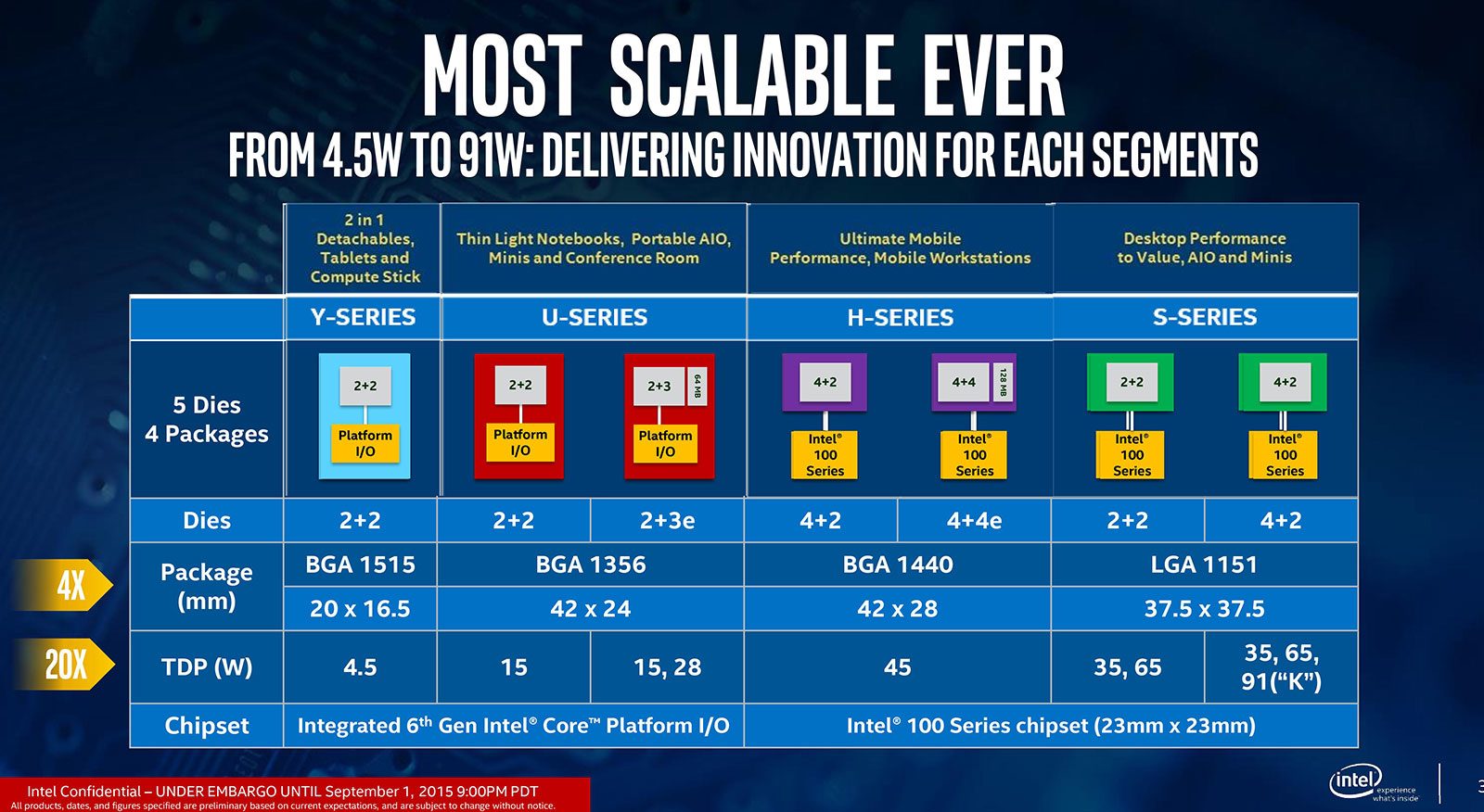
Picture of Kabylake-Y package where you can see the silicon

Here are the BGA wires on the other side of the package
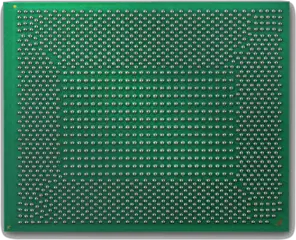
Here is the Kabylake-U series notice the PCH and the silicon of the CPU are much farther apart, and notice the large package with lots of silicon wires.

Here is the BGA wires on the other side of the package
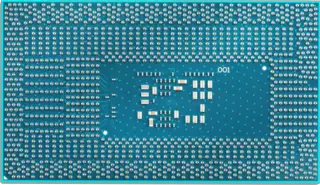

Notice the blue and yellow stuff. That is the cpu silicon. The green stuff is the package (aka plastic and metal wires) The bottom silver / grey stuff is the integrated PCH. This is why there is no silver / grey stuff on the 45w cpu for they put the PCH on the motherboard and there are more options with more pci express lanes but you get the trade off that the package is bigger.
The dimensions of the kabylake / skylake Y series package (FCBGA1515) is 20mm X 16.5mm. To put this in comparison a square inch is 0.78% of an inch by 0.65% of an inch. A postage stamp would be 22.1 mm x 24.9 mm, which is about 0.87 inches x 0.98 inches
The dimensions of the kabylake / skylake U series package (FCBGA1356) by contrast is 42mm X 24mm aka the package of the U series is 3 times the size (305.5%)

Picture of Kabylake-Y package where you can see the silicon

Here are the BGA wires on the other side of the package

Here is the Kabylake-U series notice the PCH and the silicon of the CPU are much farther apart, and notice the large package with lots of silicon wires.

Here is the BGA wires on the other side of the package

Eug
Lifer
- Mar 11, 2000
- 23,586
- 1,000
- 126
Typing this on a Kaby Lake Core m3 7Y-32, likely TDPup, but if so I'm not sure by how much. Its base clock is 1.2 GHz, but the Turbo Boost is still 3.0 GHz. (Normal base clock speed is 1.1 GHz, but Turbo Boost is the same 3.0 GHz.)So literally Intel is using the same silicon, the same wafer, the same sand etched with light in the same cpus, from all the way down to 3.5 watts (a 4.5 watt Skylake or Kabylake Y series with cTDP down) to 25 watts (a 15 watt Skylake or Kabylake U series with cTDP up)
So currently with Kabylake here are the tdp options
3.5w, 4.5w, 6.0w, 7.0 watts which uses the Kabylake Y series package
7.5w, 10.0w, 15.0w, 25.0w which uses the Kayblake U series package.
In any case, I am very pleased with it. I especially like the full HEVC support, as mentioned. CPU usage for high bitrate 10-bit 4K HEVC is under 10% using hardware decode, for a file my i7-7700K could not even cleanly decode via software while putting out a bazillion Watts of power.
Roland00Address
Platinum Member
- Dec 17, 2008
- 2,196
- 260
- 126
Typing this on a Kaby Lake Core m3 7Y-32, likely TDPup, but if so I'm not sure by how much. Its base clock is 1.2 GHz, but the Turbo Boost is still 3.0 GHz. (Normal base clock speed is 1.1 GHz, but Turbo Boost is the same 3.0 GHz.)
In any case, I am very pleased with it. I especially like the full HEVC support, as mentioned. CPU usage for high bitrate 10-bit 4K HEVC is under 10% using hardware decode, for a file my i7-7700K could not even cleanly decode via software while putting out a bazillion Watts of power.
Do you have a Macbook Adorable? Note the real name is the macbook but some people call it other nicknames like macbook one, or do you have a different computer?
Core m3 7Y-32 could go all the way up to 1.6 ghz with ctdp up for the base clock but apple with the macbook adorable decides on 1.2 ghz.
I am an ATP podcast fan and Casey Liss just recently got the 2017 Macbook Adorable which he loves
https://www.caseyliss.com/2017/6/25/macbook-adorable
But Marco hated his 2015 macbook adorable but he hates everything
https://marco.org/2015/05/19/mistake-one
Honestly though I see very little reason to get the i5 or i7, when the core m3 7Y32 is such a good processor. 20% faster turbo is not worth $250 more for the i7 vs the m3.
TRENDING THREADS
-
Discussion Intel current and future Lakes & Rapids thread
- Started by TheF34RChannel
- Replies: 23K
-
Discussion Zen 5 Speculation (EPYC Turin and Strix Point/Granite Ridge - Ryzen 9000)
- Started by DisEnchantment
- Replies: 9K
-
-
Discussion Intel Meteor, Arrow, Lunar & Panther Lakes Discussion Threads
- Started by Tigerick
- Replies: 7K
-

AnandTech is part of Future plc, an international media group and leading digital publisher. Visit our corporate site.
© Future Publishing Limited Quay House, The Ambury, Bath BA1 1UA. All rights reserved. England and Wales company registration number 2008885.

